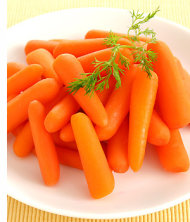
diet
Your favorite jeans did not shrink in the wash - you put on some extra pounds during the holidays, and it's time to get back into fighting shape!
The Glycemic Index Diet
One weight-loss plan that has recently gained a following was originally developed as a tool to help diabetics manage their blood sugar. It's based on the Glycemic Index (GI), a measure of the degree of how rapidly a carbohydrate is digested and released as glucose (sugar) into the blood stream, with zero being low and 100 being high. The theory behind the Glycemic Index diet is that eating low GI foods can help reduce hunger because they are broken down more slowly, so you feel fuller longer.
When you consume high GI foods, they are digested quickly, causing a blood sugar spike that's followed by a crash. The result? A vicious cycle of intense cravings and binging.
Still with me? Good.

carrots
On the surface, the GI diet seems to make sense - but so did electric-blue eyeshadow, at one point. Glycemic Index scores vary from person to person and can be altered by the cooking method, as well as the ripeness, of food. And more significantly, the GI rating does not take into account the amount of carbohydrates in a food item.
Consider a carrot. If you were to strictly follow the GI diet, then you would avoid carrots because of their high GI score. You would also choose candy over a higher-scoring potato and wash it down with a regular soda. Um, not on your life.
What to Eat
There's an ongoing debate over whether eating a low GI diet is a gimmick or an effective way to lose weight. The research is not conclusive, so like all eating plans, you have to find what works for your individual needs. If you decide to try a low GI/GL diet, here is a list of many common foods and their ratings. The Physicians Committee for Responsible Medicine (PCRM) has also put together a list of some recommended low-GI foods, including the following:
- Pumpernickel or rye bread (avoid white bread)
- Oats, bran cereals, GrapeNuts
- Most fruits
- Sweet potatoes
- Rice, barley, couscous
- Beans, peas, lentils
- Most veggies
Other Tips
- Eat loads of fiber. Build up to 40 grams per day.
- Consume "volumetric" foods. Soups, salads and foods cooked in water - like oatmeal - will make you feel full without adding lots of calories.
- Don't skip meals. A study in the Journal of Personality and Social Psychology showed that willpower is affected by the amount of glucose in the brain, and even small acts of self-control can deplete the supply.
No comments:
Post a Comment